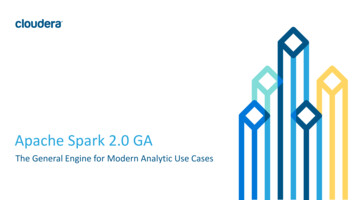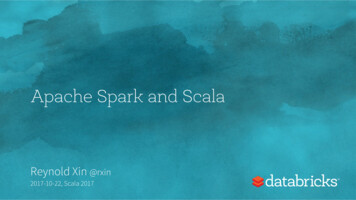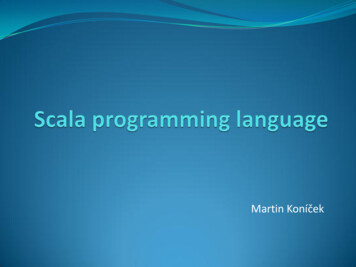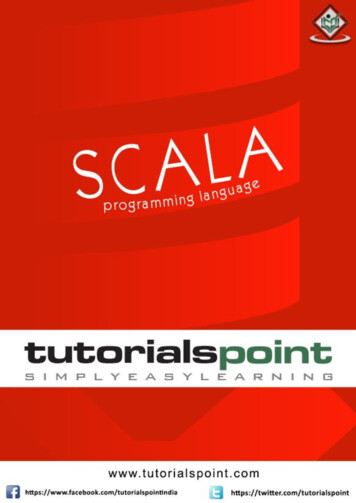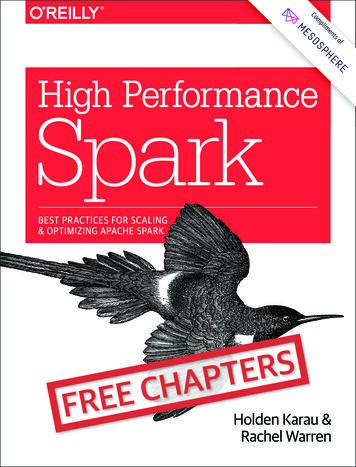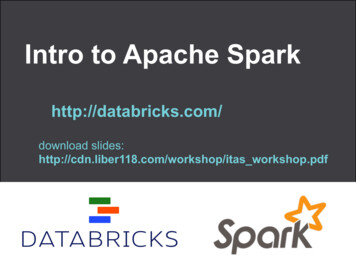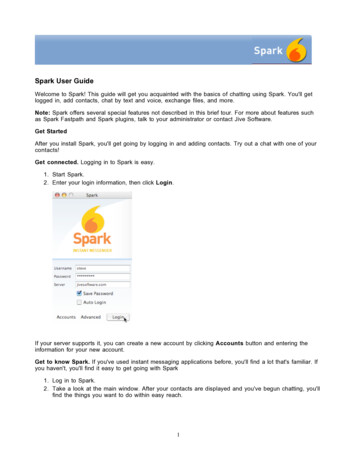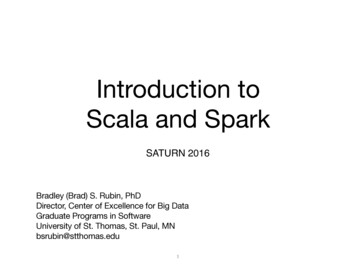
Transcription
Introduction toScala and SparkSATURN 2016Bradley (Brad) S. Rubin, PhDDirector, Center of Excellence for Big DataGraduate Programs in SoftwareUniversity of St. Thomas, St. Paul, MNbsrubin@stthomas.edu1
ScalaSparkScala/Spark ExamplesClassroom Experience2
What is Scala? JVM-based language that can call, and be called, by JavaNew: Scala.js (Scala to JavaScript compiler)Dead: Scala.Net A more concise, richer, Java functional programming Blends the object-oriented and functional paradigms Strongly statically typed, yet feels dynamically typed Stands for SCAlable LAnguageLittle scripts to big projects, multiple programming paradigms, start smalland grow knowledge as needed, multi-core, big data Developed by Martin Odersky at EPFL (Switzerland)Worked on Java Generics and wrote javac Released in 20043
Scala and JavajavacJavaScalaJVM4scalac
Scala Adoption (TIOBE)Scala is 31ston the list5
FreshmanComputer Science6
Job DemandFunctional Languages7
Scala SamplerSyntax and Features Encourages the use of immutable state No semicolonsunless multiple statements per line No need to specify types in all casestypes follow variable and parameter names after a colon Almost everything is an expression that returns a value of a type Discourages using the keyword return Traits, which are more powerful Interfaces Case classes auto-generate a lot of boilerplate code Leverages powerful pattern matching8
Scala SamplerSyntax and Features Discourages null by emphasizing the Option pattern Unit, like Java void Extremely powerful (and complicated) type system Implicitly converts types, and lets you extend closed classes No checked exceptions Default, named, and variable parameters Mandatory override declarations A pure OO languageall values are objects, all operations are methods9
Language OpinionsThere are only two kinds of languages:the ones people complain about and the ones nobody uses.— Bjarne Stroustrup10
I Like Concise, lightweight feel Strong, yet flexible, static typing Strong functional programming support Bridge to Java and its vast libraries Very powerful language constructs, if you need them Strong tool support (IntelliJ, Eclipse, Scalatest, etc) Good books and online resources11
I Don’t Like Big language, with a moderately big learning curve More than one way to do things Not a top 10 language Not taught to computer science freshman12
Java 8:Threat or Opportunity? Java 8 supports more functional features, like lambdaexpressions (anonymous functions), encroaching on Scala’sspace Yet Scala remains more powerful and concise The Java 8 JVM offers Scala better performanceRelease 2.12 will support this My prediction: Java 8 will draw more attention to functionalprogramming, and drive more Scala interest I don’t know any Scala programmers who have gone back toJava (willingly)13
Scala Ecosystem Full Eclipse/IntelliJ support REPL Read Evaluate Print Loop interactive shell Scala Worksheet interactive notebook ScalaTest unit test framework ScalaCheck property-based test framework Scalastyle style checking sbt Scala build tool Scala.js Scala to JavaScript compiler14
Functional Programming andBig Data Big data architectures leverage parallel disk, memory, and CPUresources in computing clusters Often, operations consist of independently parallel operationsthat have the shape of the map operator in functionalprogramming At some point, these parallel pieces must be brought together tosummarize computations, and these operations have the shapeof aggregation operators in functional programming The functional programming paradigm is a great fit with big dataarchitectures15
The Scala JourneyJavaScala OO featuresDays WeeksWeeks MonthsEnough Scala functional featuresto use use the Scala API inApache SparkYearsFull-blown functional programming: Lambda calculus,category theory, closures, monads, functors, actors,promises, futures, combinators, functional design patterns,full type system, library construction techniques, reactiveprogramming, test/debug/performance frameworks,experience with real-world software engineering problems 16
ScalaSparkScala/Spark ExamplesClassroom Experience17
Apache Spark Apache Spark is an in-memory big data platform that performsespecially well with iterative algorithms 10-100x speedup over Hadoop with some algorithms, especiallyiterative ones as found in machine learning Originally developed by UC Berkeley starting in 2009Moved to an Apache project in 2013 Spark itself is written in Scala, and Spark jobs can be written inScala, Python, and Java (and more recently R and SparkSQL) Other libraries (Streaming, Machine Learning, Graph Processing) Percent of Spark programmers who use each language88% Scala, 44% Java, 22% PythonNote: This survey was done a year ago. I think if it were done today, wewould see the rank as Scala, Python, and JavaSource: Cloudera/Typesafe18
Spark Architecture[KARA15]created for you as the variable called sc. Try printing out sc to see its type, as shownin Example 2-3.Example 2-3. Examining the sc variable sc pyspark.context.SparkContext object at 0x1025b8f90 Once you have a SparkContext, you can use it to build RDDs. In Examples 2-1 and2-2, we called sc.textFile() to create an RDD representing the lines of text in a file.We can then run various operations on these lines, such as count().To run these operations, driver programs typically manage a number of nodes calledexecutors. For example, if we were running the count() operation on a cluster, differ‐ent machines might count lines in different ranges of the file. Because we just ran theSpark shell locally, it executed all its work on a single machine—but you can connectthe same shell to a cluster to analyze data in parallel. Figure 2-3 shows how Sparkexecutes on a cluster.Figure 1-1. The Spark stackSpark CoreSpark Core contains the basic functionality of Spark, including components for taskscheduling, memory management, fault recovery, interacting with storage systems,and more. Spark Core is also home to the API that defines resilient distributed data‐sets (RDDs), which are Spark’s main programming abstraction. RDDs represent acollection of items distributed across many compute nodes that can be manipulatedin parallel. Spark Core provides many APIs for building and manipulating thesecollections.Spark SQLSpark SQL is Spark’spackagefor working forwithstructureddata. It inallowsFigure2-3. ComponentsdistributedexecutionSparkquerying19data via SQL as well as the Apache Hive variant of SQL—called the Hive Query Lan‐
Basic Programming Model Spark’s data model is called a Resilient Distributed Dataset (RDD) Two operationsTransformations: Transform an RDD into another RDD (i.e. Map)Actions: Process an RDD into a result (i.e. Reduce) Transformations are lazily processed, only upon an action Transformations might trigger an RDD repartitioning, called a shuffle Intermediate results can be manually cached in memory/on disk Spill to disk can be handled automatically Application hierarchyAn application consists of 1 or more jobs (an action ends a job)A job consists of 1 or more stages (a shuffle ends a stage)A stage consists of 1 or more tasks (tasks execute parallel computations)20
Wordcount in Java MapReduce(1/2)public class WordMapper extends Mapper LongWritable, Text, Text, IntWritable {IntWritable intWritable new IntWritable(1);Text text new Text();@Overridepublic void map(LongWritable key, Text value, Context context)throws IOException, InterruptedException {String line value.toString();for (String word : line.split("\\W ")) {if (word.length() 0) {text.set(word);context.write(text, intWritable);}}}}public class SumReducer extends Reducer Text, IntWritable, Text, IntWritable {IntWritable intWritable new IntWritable();@Overridepublic void reduce(Text key, Iterable IntWritable values, Context context)throws IOException, InterruptedException {int wordCount 0;for (IntWritable value : values) {wordCount ite(key, intWritable);}}21
Wordcount in Java MapReduce(2/2)public class WordCount extends Configured implements Tool {public int run(String[] args) throws Exception {Job job ount.class);job.setJobName("Word Count");FileInputFormat.setInputPaths(job, new Path(args[0]));FileOutputFormat.setOutputPath(job, new tputValueClass(IntWritable.class);return (job.waitForCompletion(true) ? 0 : 1);}public static void main(String[] args) throws Exception {int exitCode ToolRunner.run(new WordCount(), args);System.exit(exitCode);}}22
Wordcount in JavaJavaRDD String file spark.textFile(“hdfs://.");JavaRDD String words file.flatMap(new FlatMapFunction String, String () {public Iterable String call(String s) { return Arrays.asList(s.split(" ")); }});JavaPairRDD String, Integer pairs words.map(new PairFunction String, String, Integer () {public Tuple2 String, Integer call(String s) { return new Tuple2 String, Integer (s, 1); }});JavaPairRDD String, Integer counts pairs.reduceByKey(new Function2 Integer, Integer () {public Integer call(Integer a, Integer b) { return a b; }});counts.saveAsTextFile("hdfs://.");JavaRDD String lines sc.textFile(“hdfs:// ”);JavaRDD String words lines.flatMap(line - Arrays.asList(line.split(" ")));JavaPairRDD String, Integer counts words.mapToPair(w - new Tuple2 String, Integer (w, 1)).reduceByKey((x, y) - x y);counts.saveAsTextFile(“hdfs:// ”);23Java 8Java 7
Wordcount in Pythonfile spark.textFile("hdfs://.")counts file.flatMap(lambda line: line.split(" ")) \.map(lambda word: (word, 1)) \.reduceByKey(lambda a, b: a b)counts.saveAsTextFile("hdfs://.")24
Wordcount in Scalaval file spark.textFile("hdfs://.")val counts file.flatMap(line line.split(" ")).map(word (word, 1)).reduceByKey( )counts.saveAsTextFile("hdfs://.")25
Spark Shells A shell is a kind of REPL (Run Evaluate Print Loop), commonlyfound in several languages to support interactive development Python is supported via “pyspark” and iPython notebooks Scala is supported via “spark-shell” Let’s look at an example of interactive development using theSpark Scala shell26
ScalaSparkScala/Spark ExamplesClassroom Experience27
Reading in the Datascala sc.textFile(“/SEIS736/TFIDFsmall”)res0: org.apache.spark.rdd.RDD[String] /SEIS736/TFIDFsmall MapPartitionsRDD[1] at textFile at console :22 We created an RDD out of the input files, but nothing reallyhappens until we do an action, so let’s call collect(), whichgathers all the distributed pieces of the RDD and brings themtogether in our memory (dangerous for large amounts of data)scala : Array[String] Array(The quick brown fox jumps over the lazy brown dog.,Waltz, nymph, for quick jigs vex Bud.,How quickly daft jumping zebras vex.)28
Getting the Words Next, we want to split out the words. To do this, let’s try the mapfunction, which says to consider each item in the RDD array (aline) and transform it to the line split into words with W We read the map as “for each input x, replace it with x split intoan array of words”, where x is just a dummy variable Note, however, that we end up with an array of arrays of words(one array for each input file) To flatten this into just a single array of words, we need to useflatMap() instead of map()scala sc.textFile("/SEIS736/TFIDFsmall").map(x x.split(“\\W ")).collectres3: Array[Array[String]] Array(Array(The, quick, brown, fox, jumps, over,the, lazy, brown, dog), Array(Waltz, nymph, for, quick, jigs, vex, Bud),Array(How, quickly, daft, jumping, zebras, vex))29
flatMap This looks better!scala sc.textFile("/SEIS736/TFIDFsmall").flatMap(x x.split(“\\W ")).collectres4: Array[String] Array(The, quick, brown, fox, jumps, over, the, lazy, brown,dog, Waltz, nymph, for, quick, jigs, vex, Bud, How, quickly, daft, jumping, zebras, vex)30
Creating Key and Value Now, we want to make the output look like the wordcountmapper, so we do a map to take each word as input andtransform it to (word,1) While we are at it, let’s lower case the wordsc.textFile("/SEIS736/TFIDFsmall").flatMap(x x.split(“\\W ")).map(x (x.toLowerCase, 1)).collectres5: Array[(String, Int)] Array((the,1), (quick,1), (brown,1), (fox,1),(jumps,1), (over,1), (the,1), (lazy,1), (brown,1), (dog,1), (waltz,1),(nymph,1), (for,1), (quick,1), (jigs,1), (vex,1), (bud,1), (how,1),(quickly,1), (daft,1), (jumping,1), (zebras,1), (vex,1))31
Sum Reducing Now, let’s do the sum reducer function with reduceByKey, whichsays to run through all the elements for each unique key, andsum them up, two at a time The underscores are Scala shorthand for “first number, secondnumber”scala sc.textFile("/SEIS736/TFIDFsmall").flatMap(x x.split(“\\W ")).map(x (x.toLowerCase, 1)).reduceByKey( ).collectres6: Array[(String, Int)] Array((fox,1), (bud,1), (vex,2), (jigs,1), (over,1),(for,1), (brown,2), (the,2), (jumps,1), (jumping,1), (daft,1), (quick,2), (nymph,1),(how,1), (lazy,1), (zebras,1), (waltz,1), (dog,1), (quickly,1))32
Sorting For fun, let’s sort by keyscala sc.textFile("/SEIS736/TFIDFsmall").flatMap(x x.split(“\\W ")).map(x (x.toLowerCase, 1)).reduceByKey( ).sortByKey().collectres7: Array[(String, Int)] Array((brown,2), (bud,1), (daft,1), (dog,1), (for,1),(fox,1), (how,1), (jigs,1), (jumping,1), (jumps,1), (lazy,1), (nymph,1), (over,1),(quick,2), (quickly,1), (the,2), (vex,2), (waltz,1), (zebras,1))33
Writing to HDFS Finally, let’s write the output to HDFS, getting rid of the collect Why 3 output files?We had 3 partitions when we originally read in the 3 input files, andnothing subsequently changed thatscala sc.textFile("/SEIS736/TFIDFsmall").flatMap(x x.split(“\\W ")).map(x (x.toLowerCase, 1)).reduceByKey( ).sortByKey().saveAsTextFile(“swc")scala exit[brad@hc ] hadoop fs -ls swcFound 4 items-rw-r--r-- 3 brad supergroup-rw-r--r-- 3 brad supergroup-rw-r--r-- 3 brad supergroup-rw-r--r-- 3 brad supergroup0 2015-10-24 06:46 swc/ SUCCESS59 2015-10-24 06:46 swc/part-0000059 2015-10-24 06:46 swc/part-0000159 2015-10-24 06:46 swc/part-0000234
Seeing Our Output[brad@hc ] hadoop fs -cat 1)(fox,1)(how,1)[brad@hc ] hadoop fs -cat (nymph,1)(over,1)[brad@hc ] hadoop fs -cat altz,1)(zebras,1)35
An Alternative Style While the on-liner style (also known as a fluent style) is concise,it is often easier to develop and debug by assigning eachfunctional block to a variable Note that nothing really happens until the the actions(reduceByKey and saveAsTextFile) are executedscala val lines sc.textFile(“/SEIS736/TFIDFsmall”)scala val words lines.flatMap(x x.split(“\\W "))scala val mapOut words.map(x (x.toLowerCase, 1))scala val reduceOut mapOut.reduceByKey( )scala val sortedOut reduceOut.sortByKey()scala sortedOut.saveAsTextFile("swc")36
Make it a Standalone Programpackage edu.stthomas.gps.sparkimport org.apache.spark.{SparkConf, SparkContext}object SparkWordCount {def main(args: Array[String]) {val sparkConf new SparkConf().setAppName("Spark WordCount")val sc new small").flatMap(x x.split("\\W ")).map(x (x.toLowerCase, 1)).reduceByKey( ).sortByKey()spark-submit \.saveAsTextFile("swc")--class edu.stthomas.gps.spark.SparkWordCount \--master yarn-cluster \--executor-memory 512M \--num-executors 2 \/home/brad/spark/spark.jarSystem.exit(0)}}37
Dataframes Dataframes are like RDDs, but they are used for structured data They were introduced to support SparkSQL, where a data frameis like a relational table But, they are starting to see more general use, outside ofSparkSQL, because of the higher-level API and optimizationopportunities for performance38
Dataframe Examplescala val stocks 31.30,30.63,31.30,1020500,31.30")scala case class Stock(exchange: String, symbol: String, date: String, open: Float, high:Float, low: Float, close: Float, volume: Integer, adjClose: Float)scala val Stocks stocks.map( .split(“,")).map(x ala val StocksRDD sc.parallelize(Stocks)scala val StocksDF StocksRDD.toDF39
Dataframe Examplescala StocksDF.countres0: Long 3scala StocksDF.firstres1: org.apache.spark.sql.Row ,10.28]scala StocksDF.show -------- ------ ---------- ----- ----- ----- ----- ------- -------- exchange symbol date open high low close volume adjClose -------- ------ ---------- ----- ----- ----- ----- ------- -------- NYSE BGY 2010-02-08 10.25 10.39 9.94 10.28 600900 10.28 NYSE AEA 2010-02-08 4.42 4.42 4.21 4.24 205500 4.24 NYSE CLI 2010-02-12 30.77 31.3 30.63 31.3 1020500 31.3 -------- ------ ---------- ----- ----- ----- ----- ------- -------- 40
Dataframe Examplescala StocksDF.printSchemaroot -- exchange: string (nullable true) -- symbol: string (nullable true) -- date: string (nullable true) -- open: float (nullable false) -- high: float (nullable false) -- low: float (nullable false) -- close: float (nullable false) -- volume: integer (nullable true) -- adjClose: float (nullable false)scala StocksDF.groupBy("date").count.show ---------- ----- date count ---------- ----- 2010-02-08 2 2010-02-12 1 ---------- ----- scala StocksDF.groupBy("date").count.filter("count 1").rdd.collectres2: Array[org.apache.spark.sql.Row] Array([2010-02-08,2])41
Dataframe Using SQLscala StocksDF.registerTempTable("stock")scala sqlContext.sql("SELECT symbol, close FROM stock WHERE close 5 ORDER BY symbol").show ------ ----- symbol close ------ ----- BGY 10.28 CLI 31.3 ------ ----- 42
Dataframe Read/Write Interface The read/write interface makes it very easy to read and writecommon data formats43
Dataframe Read/Write Interface Reading in a JSON file as a Dataframescala val df son")scala df.printSchemaroot -- id: string (nullable true) -- city: string (nullable true) -- loc: array (nullable true) -- element: double (containsNull true) -- pop: long (nullable true) -- state: string (nullable true)scala df.countres0: Long 29467scala df.filter(" id 55105").show ----- ---------- -------------------- ----- ----- id city loc pop state ----- ---------- -------------------- ----- ----- 55105 SAINT PAUL [-93.165148, 44.9. 26216 MN ----- ---------- -------------------- ----- ----- 44
Dataframe Read/Write Interface Converting the Dataframe to Parquet format, and then querying itas a Hive tablescala val options Map("path" - “/user/hive/warehouse/zipcodes")scala ptions).saveAsTable("zipcodes")hive DESCRIBE zipcodes;OKidstringcitystringlocarray double popbigintstatestringhive SELECT city FROM zipcodes WHERE ( id '55105');SAINT PAUL45
ScalaSparkScala/Spark ExamplesClassroom Experience46
Classroom Experience After a 1/2 semester of Hadoop Java MapReduce programming,I introduce Scala and Spark in two 3-hour lectures/demos Almost all students are able to successfully complete twohomework assignments (one heavily guided, one withoutdirection) Students enjoy the interactive shell style of development,concise API, expressiveness, and easier/faster overalldevelopment time/effortAbout 50% of students change their course project proposals to useScala/Spark after this experience Two major hurdlesSpark is lazy, so errors are initially attributed to actions, yet the rootcause is often a preceding transformationStudents often confuse the Spark and Scala APIs47
The Scala Journey 16 Java Scala OO features Enough Scala functional features to use use the Scala API in Apache Spark Full-blown functional programming: Lambda calculus, category theory, closures, monads, functors, actors, promises, futures, combinators, functional design patterns, fu

